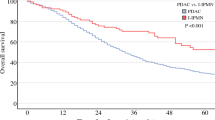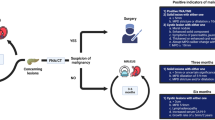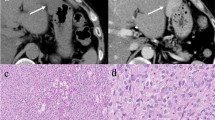Abstract
Purpose
This study was made to evaluate long-term results of an aggressive surgical approach for pancreaticoduodenal neuroendocrine neoplasms (pNENs) in patients with multiple endocrine neoplasia type 1 (MEN1).
Methods
MEN1 patients with either biochemical evidence of functioning or non-functioning pNENs larger than 1 cm in size on imaging underwent duodenopancreatic surgery. Since 1997, patients were followed annually by biochemical testing and imaging studies.
Results
Thirty-eight genetically confirmed MEN1 patients underwent duodenopancreatic resection for functioning (n = 22) or non-functioning (n = 16) pNENs, nine patients were yet not operated. Malignant disease occurred in 12 (35%) patients defined by either lymph node (12 patients) and/or distant metastases (2 patients). Six patients with Zollinger-Ellison syndrome (ZES) required pylorus-preserving pancreaticoduodenectomy (PPPD) as initial or redo procedure and 32 patients underwent other duodenopancreatic resections. Ten (26%) patients underwent up to four reoperations for either recurrent or metastatic disease that resulted in completion pancreatectomy in four patients. After median 109 months, 44 patients were alive and three patients died, one due to thymic carcinoid and two of unrelated causes. All eight patients with organic hyperinsulinism and 7 of 13 patients with ZES were biochemically cured. However, 24 of 38 (78%) patients developed new pNENs in the pancreatic remnant, but none developed distant metastases.
Conclusions
Early resection of pNENs in MEN1 may prevent the development of distant metastases. However, the majority of patients develop new pNENs in the duodenopancreatic remnant which may require completion pancreatectomy in the long term.


Similar content being viewed by others
References
Brandi ML, Gagl RF, Angeli et al (2001) Guidelines for diagnosis and therapy of MEN type 1 and type 2. J Clin Endocrinol Metab 86:5658–5671
Trump D, Farren B, Wooding C et al (1996) Clinical studies of multiple endocrine neoplasia type 1 (MEN1). QJ Med 89:653–669
Grama D, Skogseid B, Wilander E, Eriksson B, Martensson H, Cedermark B et al (1992) Pancreatic tumors in multiple endocrine neoplasia type 1: clinical presentation and surgical treatment. World J Surg 16:611–618
Marx S, Spiegel AM, Skarulis MC et al (1998) Multiple endocrine neoplasia type 1: clinical and genetic topics. Ann Intern Med 129:484–494
Schussheim DH, Skarulis MC, Agarwal SK et al (2001) Multiple endocrine neoplasia type 1: new clinical and basic findings. Trends Endocrinol Metab 12:173–178
Carty SE, Helm AK, Amico JA et al (1998) The variable penetrance and spectrum of manifestations of multiple endocrine neoplasia type 1. Surgery 124:1106–1111
Eriksson B, Oberg K (2000) Neuroendocrine tumours of the pancreas. BJS 87:129–131
Gibril F, Schumann M, Pace A et al (2004) Multiple endocrine neoplasia type 1 and Zollinger–Ellison syndrome: a prospective study of 107 cases and comparison with 1009 cases from the literature. Medicine (Baltimore) 83:43–83
Waldmann J, Fendrich V, Habbe N, Bartsch DK et al (2009) Screening of patients with endocrine neoplasia type 1 (MEN-1): a critical analysis of its value. World J Surg 33:1208–1218
Thomas-Marquez L, Murat A, Delemer B et al (2006) Prospective endoscopic ultrasonographic evaluation of the frequency of nonfunctioning pancreaticoduodenal endocrine tumors in patients with multiple endocrine neoplasia type 1. Am J Gastroenterol 101:266–273
Goudet P, Murat A, Binquet C et al (2010) Risk factors and causes of death in MEN1 disease. A GTE (Groupe d’Etude des Tumeurs Endocrines) cohort study among 758 patients. World J Surg 34(2):249–255
Doherty GM, Olson JA, Frisella MM et al (1998) Lethality of multiple endocrine neoplasia type I. World J Surg 22:581–587
Bartsch D, Kopp I, Bergenfelz A, Rieder H, Münch K, Jäger K et al (1998) MEN1 gene mutations in 12 MEN1 families and their associated tumors. Eur J Endocrinol 139(4):416–420
Agarwal SK, Kester MB, Debelenko LV, Heppner C, Emmert-Buck MR, Skarulis MC (1997) Germline mutations of the MEN1 gene in familial multiple endocrine neoplasia type 1 and related states. Hum Mol Genet 6:1169–1175
Bartsch DK, Langer P, Wild A et al (2000) Pancreaticoduodenal endocrine tumors in multiple endocrine neoplasia type 1: surgery or surveillance? Surgery 128:958–966
Kouvaraki MA, Shapiro SE, Cote GJ, Lee JE et al (2006) Management of pancreatic endocrine tumors in multiple endocrine neoplasia type 1. World J Surg 30(5):643–653
Schaaf L, Pickel J, Zinner K, Hering U, Höfler M, Goretzki PE et al (2007) Developing effective screening strategies in multiple endocrine neoplasia type 1 (MEN 1) on the basis of clinical and sequencing data of German patients with MEN 1. Exp Clin Endocrinol Diab 115(8):509–517
Jensen RT, Berna MJ, Bingham DB, Norton JA (2008) Inherited pancreatic endocrine tumor syndromes: advances in molecular pathogenesis, diagnosis, management, and controversies. Cancer 113(7 Suppl):1807–1843
Norton JA, Alexander HR, Fraker DL et al (2001) Comparison of surgical results in patients with advanced and limited disease with multiple endocrine neoplasia type 1 and Zollinger–Ellison syndrome. Ann Surg 234:495–505
Thompson NW (1998) Current concepts in the surgical management of multiple endocrine neoplasia type 1 pancreatic-duodenal disease. Results in the treatment of 40 patients with Zollinger–Ellison-syndrome, hypoglycaemia or both. J Intern Med 243:495–500
Norton JA, Fraker DL, Alexander HR et al (1999) Surgery to cure the Zollinger–Ellison syndrome. N Engl J Med 341:635–644
Bartsch DK, Langer P, Fendrich V et al (2005) Outcome of duodenopancreatic resections in patients with multiple endocrine neoplasia type 1. Ann Surg 242:757–764
Kann PH, Balakina E, Ivan D, Bartsch DK, Meyer S, Klose KJ, Behr T, Langer P (2006) Natural course of small, asymptomatic neuroendocrine pancreatic tumours in multiple endocrine neoplasia type 1: an endoscopic ultrasound imaging study. Endocr Relat Cancer 13(4):1195–1202
Imamura M, Takahashi K (1993) Use of selective secretin injection test to guide surgery in patients with Zollinger Ellison syndrome. World J Surg 17:433–438
Bassi C, Dervenis C, Butturini G et al (2005) Postoperative pancreatic fistula: an international study group (ISGPF) definition. International Study Group on Pancreatic Fistula Definition. Surgery 138(1):8–13
Triponez F, Dosseh D, Goudet P, Cougard P (2006) Epidemiology data on 108 MEN 1 patients from the GTE with isolated nonfunctioning tumors of the pancreas. Ann Surg 243:265–272
Skogseid B et al (1998) Multiple endocrine neoplasia type 1: a 10-year prospective screening study in four kindreds. J Clin Endocrinol Metab 243:489–494
Gauger PG, Doherty GM, Broome JT, Miller BS, Thompson N (2009) Completion pancreatectomy and duodenectomy for recurrent MEN-1 pancreaticoduodenal endocrine neoplasms. Surgery 146:801–806
Demeure MJ, Klonoff DC, Karam JH, Duh QY, Clark OH (1991) Insulinomas associated with multiple endocrine neoplasia type I: the need for a different surgical approach. Surgery 110(6):998–1004, discussion 1004-5
Akerström G, Hessman O, Skogseid B (2002) Timing and extent of surgery in symptomatic and asymptomatic neuroendocrine tumors of the pancreas in MEN1. Langenbecks Arch Surg 386:558–569
O’Riordain DS, O’Brien T, van Heerden JA, Service FJ, Grant CS (1994) Surgical management of insulinoma associated with multiple endocrine neoplasia type I. World J Surg 18(4):488–493, discussion 493-4
Langer P, Kann PH, Fendrich V, Bartsch DK et al (2004) Prospective evaluation of imaging procedures for the detection of pancreaticoduodenal endocrine tumors in patients with multiple endocrine neoplasia type 1. World J Surg 28:1317–1322
Tonelli F, Fratini G, Falchetti A, Nesi G, Brandi ML (2005) Surgery for gastroenteropancreatic tumours in multiple endocrine neoplasia type 1: review and personal experience. J Intern Med 257:38–49
Imamura M, Komoto I, Doi R, Onodera H, Kobayashi H, Kawai Y (2005) New pancreas-preserving total duodenectomy technique. World J Surg 29:203–207
Cullen JJ, Sarr MG, Ilstruup DM (1994) Pancreatic anastomotic leak after pancreaticoduodenectomy: incidence, significance and management. Am J Surg 168:295–298
Skogseid B, Rastad J, Akerstrom G Pancreatic endocrine tumors in multiple neoplasia type 1. In: Doherty GM, Skogseid B (eds) Surgical endocrinology. Lippincott Williams & Wilkins, Philadelphia, 511–525
Falconi M, Plockinger U, Kwekkeboom DJ et al (2006) Consensus Conference. European Neuroendocrine Tumor Society. Well-differentiated pancreatic nonfunctioning tumors/carcinoma. Neuroendocrinology 84:196–211
Fernandez-Cruz L, Cesar-Borges G (2006) Laparoscopic strategies for resection of insulinoma. J Gastrointest Surg 10:752–760
Proye CAG, Lokey JS (2004) Current concepts in functioning endocrine tumors of the pancreas. World J Surg 28:1231–1238
Lowney JK, Frisella MM, Lairmore TC, Doherty GM (1998) Pancreatic islet cell tumor metastasis in multiple endocrine neoplasia type 1: a correlation with primary tumor size. Surgery 124:1043–1048
Lairmore TC, Chen VY, De Benedetti MK, Gillanders WE, Norton JA, Doherty GM (2000) Duodenopancreatic resections in patients with multiple endocrine neoplasia type 1. Ann Surg 231:909–918
Cadiot G, Vuagnat A, Doukhan I, Murat A, Bonnaud G, Delemer B (1999) Prognostic factors in patients with Zollinger–Ellison syndrome and multiple endocrine neoplasia type 1. Groupe d’Etude des Néoplasies Endocriniennes Multiples (GENEM and groupe de Recherche et d’Etude du Syndrome de Zollinger–Ellison (GRESZE). Gastroenterology 116(2):286–293
Acknowledgement
We are grateful to Alexander Epson for critical reading of the manuscript.
Conflicts of interest
None.
Author information
Authors and Affiliations
Corresponding author
Rights and permissions
About this article
Cite this article
Lopez, C.L., Waldmann, J., Fendrich, V. et al. Long-term results of surgery for pancreatic neuroendocrine neoplasms in patients with MEN1. Langenbecks Arch Surg 396, 1187–1196 (2011). https://doi.org/10.1007/s00423-011-0828-1
Received:
Accepted:
Published:
Issue Date:
DOI: https://doi.org/10.1007/s00423-011-0828-1




